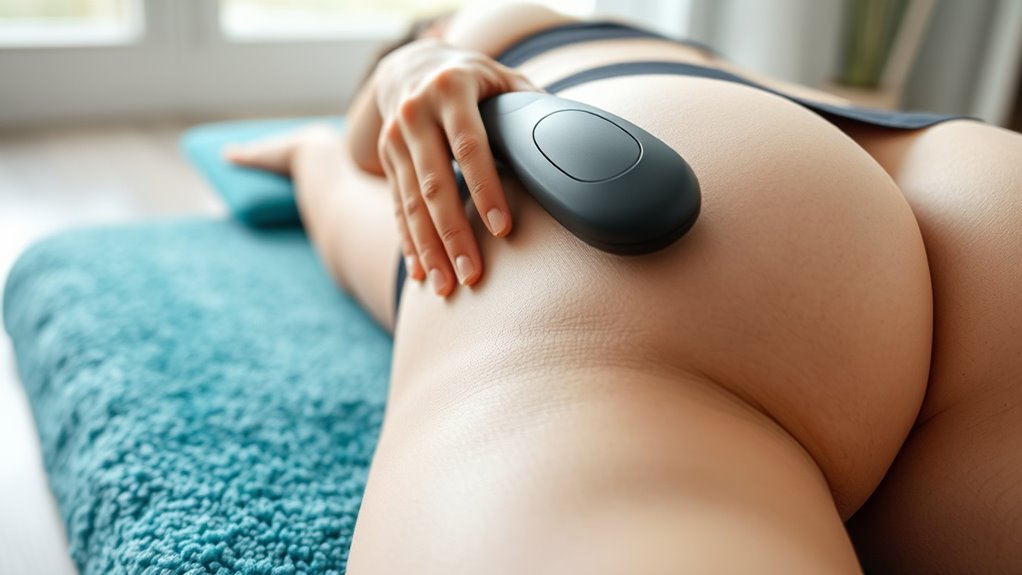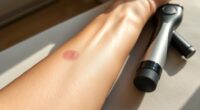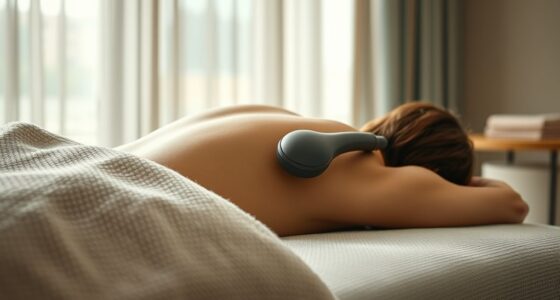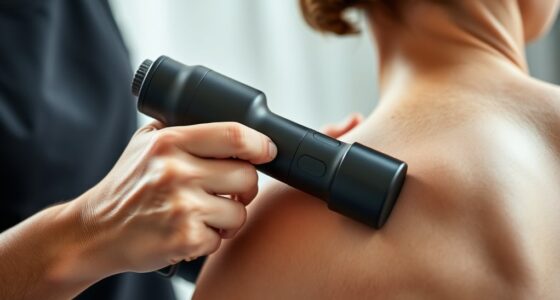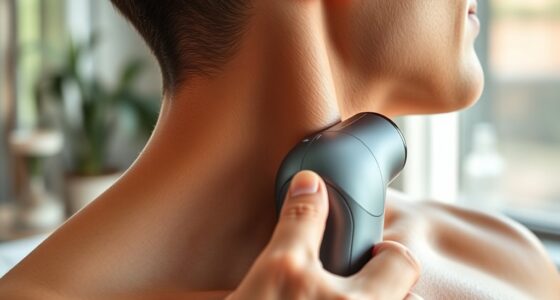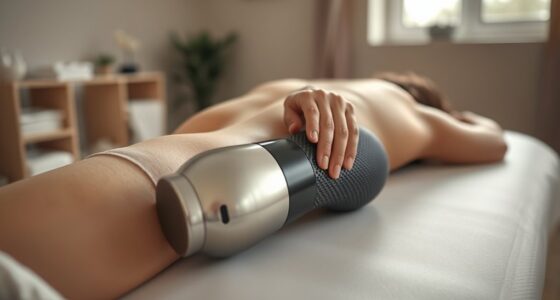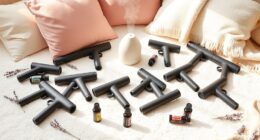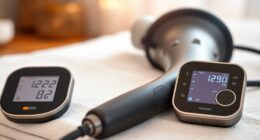To effectively use percussive therapy for hip pain and bursitis, select a device with adjustable settings and start with low intensity. Focus on gentle, slow movements around the hip, avoiding direct pressure on bursae, and target surrounding muscles like the glutes and outer thigh. Use softer attachments for sensitivity, and always listen to your body. Proper technique and safety precautions help minimize discomfort, and exploring these tips further can enhance your recovery.
Key Takeaways
- Target the hip area gently, focusing on surrounding muscles like glutes and outer thigh, avoiding direct pressure on bursae.
- Use softer, rounded attachments at lower settings to relax muscles and reduce inflammation safely.
- Start with low intensity and gradually increase to prevent discomfort and ensure effective therapy.
- Apply percussive pulses for short sessions, avoiding prolonged pressure on the same spot to prevent irritation.
- Always inspect your device, follow safety precautions, and stop if pain or discomfort occurs during treatment.
Understanding How Percussive Therapy Alleviates Hip Pain and Bursitis
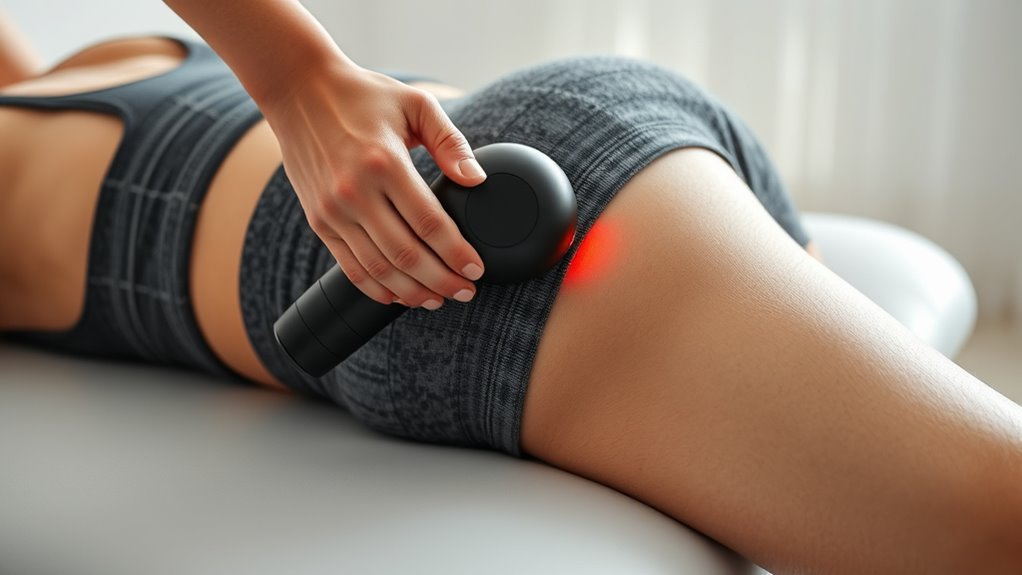
Percussive therapy works by delivering rapid, targeted pulses to the muscles and surrounding tissues, which helps reduce pain and inflammation associated with bursitis. When applied to the hip area, it specifically targets the hip muscle involved in bursitis pain, helping to loosen tight muscles and improve blood flow. This stimulation can break up adhesions and reduce muscle tension that often worsens bursitis symptoms. As you use percussive therapy, you may notice a decrease in discomfort, making daily movements easier. The therapy works by encouraging natural healing processes, easing the pressure on the bursae. Consistent use can lead to significant relief by addressing the root causes of hip pain linked to muscle tightness and inflammation.
Choosing the Right Percussive Device and Settings
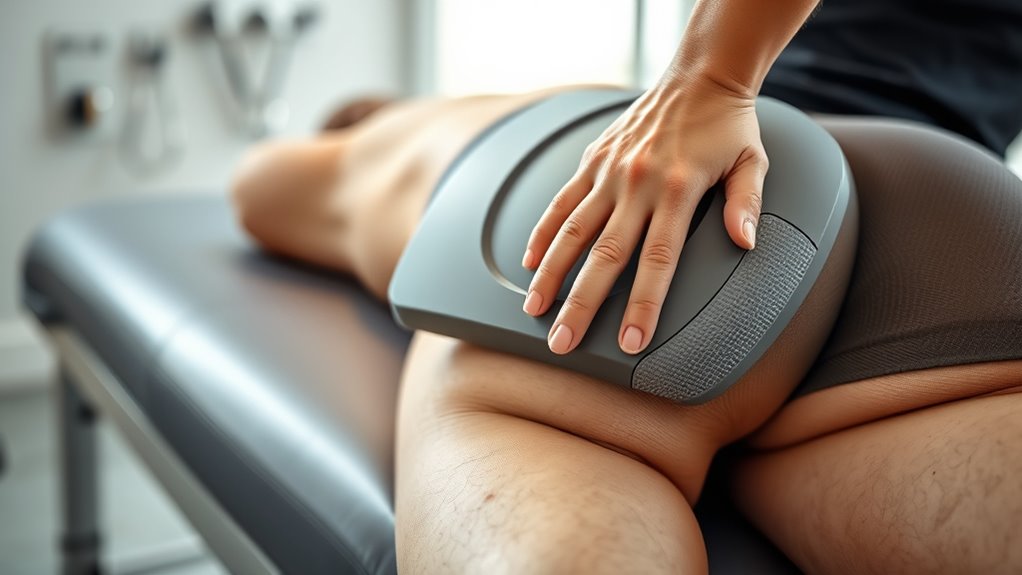
When selecting a percussive device, start by considering the power levels to match your comfort and needs. Choosing the right attachment can make a big difference in targeting specific hip areas effectively. Keep these tips in mind to optimize your therapy sessions and get the best results. Regularly cleaning your device and replacing worn attachments can also help maintain its effectiveness over time maintenance and longevity.
Device Power Levels
Choosing the right device power level is essential for effective relief and safety. Your device customization options allow you to adjust intensity for a comfortable experience. Start with a lower setting and gradually increase until you find a level that relieves pain without causing discomfort. Higher power levels can provide deeper tissue penetration, but they might also escalate sensitivity or irritation if used improperly. Pay attention to your user experience—if a setting feels too intense or causes pain, dial back immediately. Properly adjusting power levels ensures you target your bursitis effectively while minimizing risks. Remember, the goal is to find a balance that offers relief without overstimulating your tissues. Tailoring power levels to your needs maximizes the benefits of percussive therapy. Using the appropriate device material can also influence heat retention and comfort during therapy sessions.
Attachment Selection Tips
Selecting the appropriate attachment and device settings is essential for effective relief and comfort. For muscle relaxation, choose attachments with softer, rounded tips that target larger muscle groups without causing discomfort. If you’re seeking pain relief around bursitis or sensitive areas, opt for smaller, more focused attachments that provide precise percussive force. Adjust the device’s speed and intensity to match your comfort level—start low and increase gradually as needed. A gentler attachment with moderate settings can help loosen tight muscles, reduce inflammation, and alleviate pain. Keep in mind that using the right attachment and settings minimizes discomfort while maximizing benefits. This tailored approach ensures you get the most effective percussive therapy for your hip pain and bursitis. Additionally, understanding cybersecurity principles can help protect your personal health data when managing your treatment plans online.
Proper Technique for Applying Percussive Therapy to the Hip Area
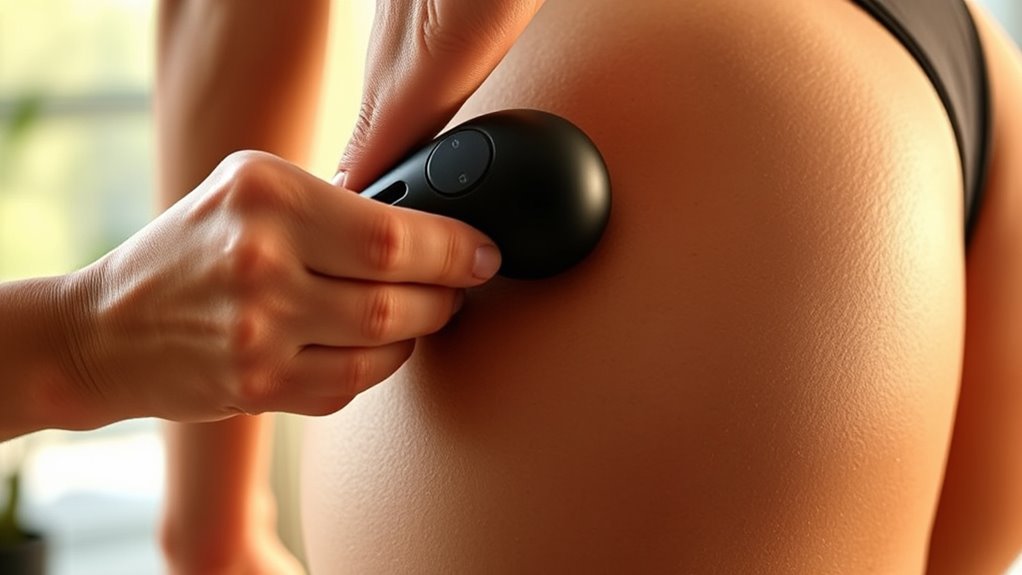
To effectively relieve hip pain and bursitis with percussive therapy, it’s important to apply the device correctly. Start by understanding hip anatomy, focusing on the bursae—fluid-filled sacs that reduce friction between tissues. Since bursitis causes inflammation, target the area around the greater trochanter, where bursitis commonly occurs. Hold the device at a 45-degree angle and keep it moving slowly over the hip muscles, avoiding direct pressure on the bursa itself. Use gentle, consistent strokes to stimulate blood flow and reduce inflammation. Maintain contact with the skin but don’t press too hard. Focus on surrounding muscles like the glutes and outer thigh, which support the hip joint and help alleviate pain caused by bursitis. Developing leadership skills such as patience and attention to detail can enhance your ability to perform self-care routines effectively.
Precautions and Safety Tips During Treatment
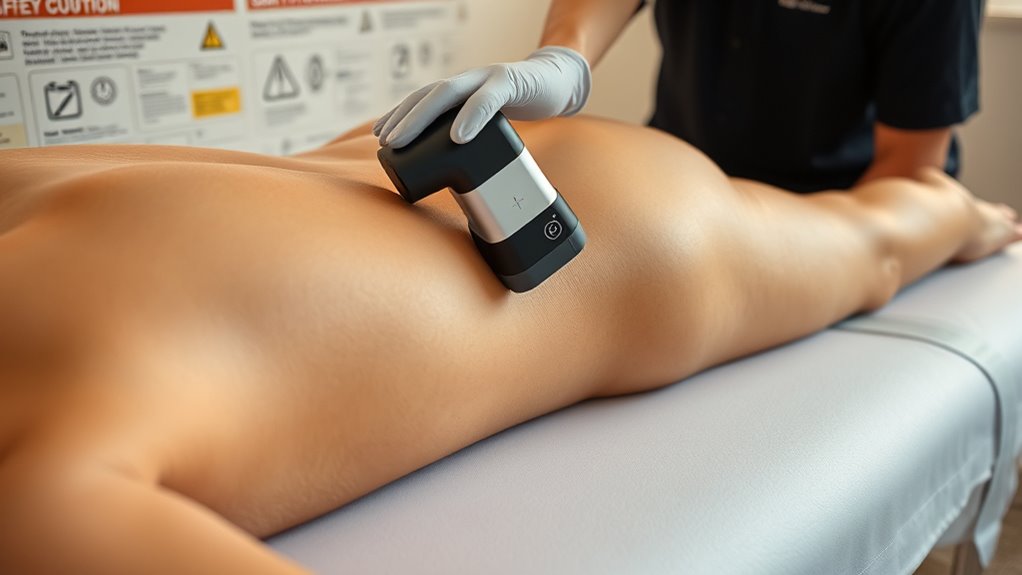
While percussive therapy can effectively reduce hip pain and bursitis, it’s essential to follow safety precautions to prevent injury. Always inspect your device before use to verify proper device maintenance, such as checking for loose parts or damage. This prevents malfunctions that could cause harm. Pay close attention to skin safety; avoid applying the device directly over broken or irritated skin, and don’t press too hard. Use a protective barrier like a cloth if needed. Limit treatment sessions to recommended durations and avoid staying on the same spot too long. If you experience discomfort, dizziness, or unusual pain, stop immediately and consult a healthcare professional. Following these precautions helps maximize safety and effectiveness during your therapy. Additionally, being aware of popular water park amenities can enhance your overall experience if used in conjunction with recovery activities or family outings.
Incorporating Percussive Therapy Into Your Overall Recovery Plan
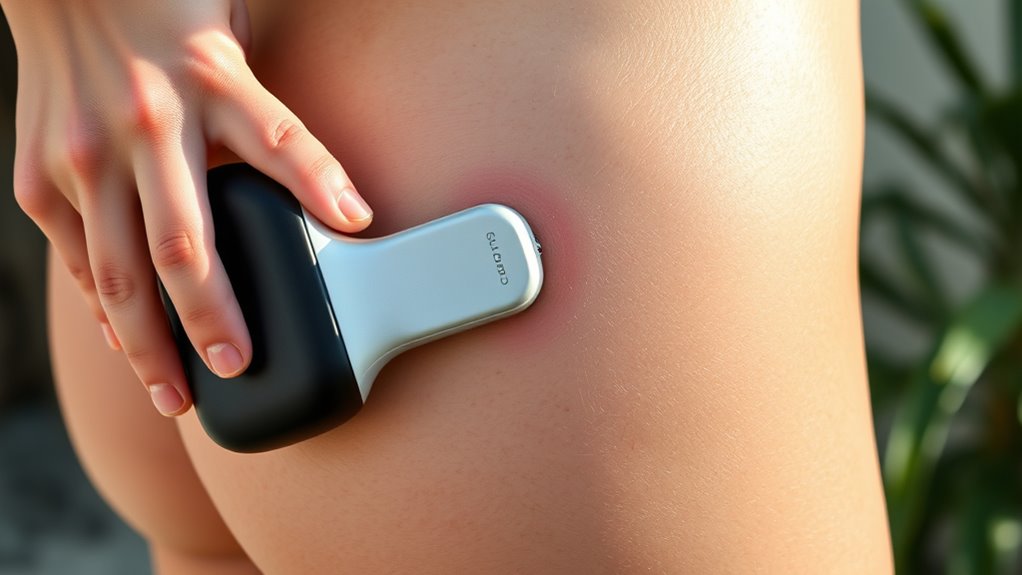
Integrating percussive therapy into your overall recovery plan can enhance healing when combined with other treatments and lifestyle adjustments. It supports muscle flexibility and aids pain management, making your recovery more effective. To maximize benefits, consider these strategies:
- Incorporate stretching routines to improve flexibility alongside therapy sessions
- Maintain a balanced diet that promotes tissue repair
- Use heat or cold therapy for additional pain relief
- Engage in low-impact exercises to strengthen surrounding muscles
- Prioritize rest to allow proper recovery
- Incorporate massage techniques to further relax muscles and improve circulation
When to Seek Professional Guidance and Additional Treatment
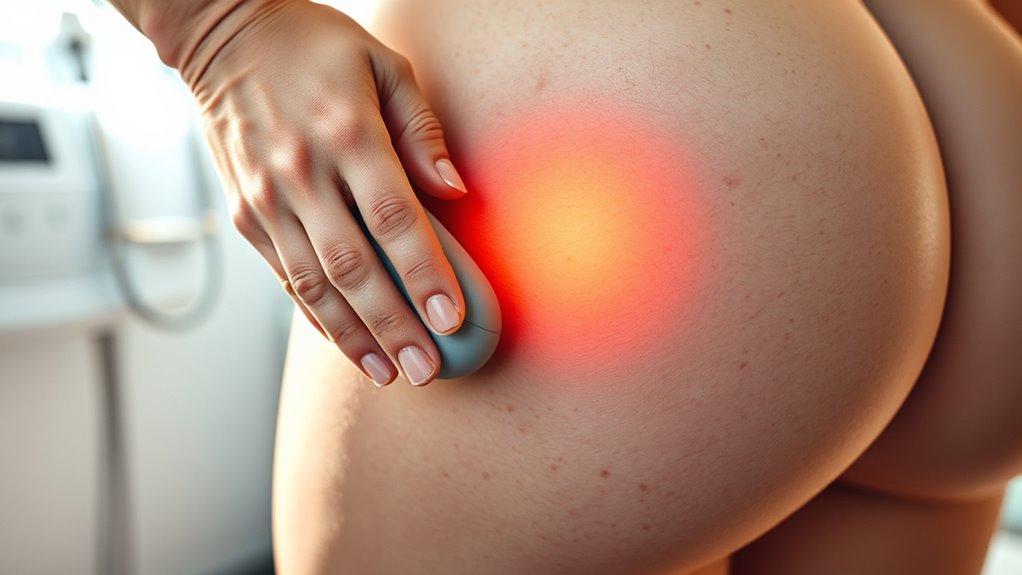
Recognizing when to seek professional guidance is essential for effective treatment of hip pain and bursitis. If pain persists beyond a few days, worsens, or limits your daily activities, consult a healthcare provider. Medical diagnostics, such as imaging or physical exams, help identify underlying issues. In some cases, conservative treatments aren’t enough, and surgical interventions may be necessary. Understanding these options ensures you receive appropriate care. Notably, a proper diagnosis can also determine if conservative treatment options like physical therapy or medication are suitable before considering surgery.
Frequently Asked Questions
Can Percussive Therapy Worsen Bursitis Symptoms?
You might wonder if percussion intensity could worsen bursitis flare ups. It’s possible if you use too much force or apply therapy directly over inflamed areas. To avoid worsening symptoms, start with gentle percussion and monitor how your body responds. If you notice increased pain or discomfort, reduce the intensity or stop. Always listen to your body and consult a healthcare professional before continuing therapy during flare ups.
How Often Should I Use Percussive Therapy for Hip Pain?
You should start with a moderate usage frequency, about 2-3 times a week, to see how your body responds. Pay attention to your hip’s reaction and avoid overdoing it, as excessive use can cause irritation. To optimize effectiveness, combine percussive therapy with gentle stretching and rest. Adjust the frequency based on pain relief and comfort, ensuring you’re not aggravating your condition while aiming for the best results.
Is Percussive Therapy Safe for Chronic Bursitis Sufferers?
You may wonder if percussive therapy is safe for chronic bursitis sufferers. While it can be effective for bursitis management, you should consult your healthcare provider first. Therapy safety depends on your specific condition, and overuse might aggravate inflammation. Use gentle settings and avoid painful areas. Always follow professional advice to make certain the therapy supports healing without causing further irritation.
Can I Use Percussive Therapy Alongside Medications?
Think of your body as a finely tuned instrument. You can use percussive therapy alongside medications, but you should be mindful of medication interactions and therapy timing. Always check with your healthcare provider to make sure this combo is safe for you. Proper timing can maximize benefits and reduce risks, helping you tune your recovery without discord. Your provider’s guidance is key to harmonizing therapy and medications effectively.
What Are Signs of Overuse or Adverse Effects?
You might notice muscle soreness or joint irritation if you overuse percussive therapy. These signs indicate you’re applying too much pressure or using it too frequently. If you experience increased pain, swelling, or tenderness, stop immediately and give your body time to recover. Always listen to your body and avoid overdoing it, as overuse can lead to adverse effects like heightened discomfort or tissue damage.
Conclusion
Remember, patience is a virtue when it comes to healing. By using percussive therapy correctly, you can ease your hip pain and bursitis effectively. Stay consistent, listen to your body, and don’t rush the process. If something feels off, seek professional guidance. As the saying goes, “Slow and steady wins the race.” Trust in your recovery journey—you’ll get back to feeling your best sooner than you think.
